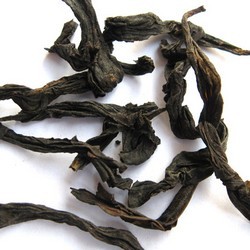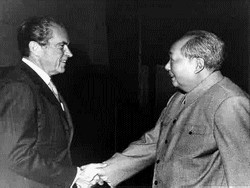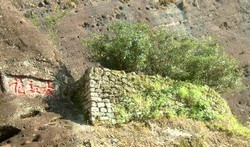Dahongpao Tea (Big Red Robe)
King of Oolong Rediscovered



Add Your Review | Read all reviews
What does Dahongpao tea means to ordinary people like you and me? Two excellent AAA and AA graded teas from the Wuyi Mountain, with the latter being heavily roasted.
Among all the Chinese oolong teas that exist, none is so hyped up as this King of Oolong.
What's the story behind this legendary tea? How can we, as 21st century tea drinker, repair our connection with the him?
The Origin
The word Dahongpao means Big Red Robe. The original tea plant is found in the Nine Dragon Cave, where the Six Tea Bushes reside today.
He is prized for its health-enhancing property.
According to a legend, a scholar fell ill on-route to Beijing to take the Imperial Examination. A monk cured him using the tea leaves plucked from the Six Tea Bushes.
When he returned later, having passed his the Examination with flying colors, he offered a Red Robe as a gesture of gratitude.
The Legends
 Perched on a cliff, the Six Tea Bushes have lived for more than six hundreds years.
Perched on a cliff, the Six Tea Bushes have lived for more than six hundreds years.
It is said that during the Cultural Revolution, policy guards kept watch 24/7, to safeguard them from the marauding revolutionaries.
When President Nixon visited, Chairman Mao presented him with 100 grams of tea leaves. When Nixon alluded to Mao's "stinginess", Premier Zhou explained such tiny quantity is worth half of Chinese Empire.
Today, the Six Tea Bushes produce less than 100 grams of leaves each year, all of which is retained by the State government. Only a precious little is seen or heard in the real world.
The first medallist of the Beijing Olympic 2008 was awarded this tea. A 2002 State auction saw 20 grams sold for more than 30 thousands dollars to a restaurant in Guangzhou.
Back to Top of Dahongpao Tea
Back Wuyi Tea Main Page
Back to Tea Shop Main Page
AAA Grade (Spring 2024) - 48 grams
 Being the most famous tea of Wuyi Mountain has many drawbacks, attracting not only a price premium, but also cheap imitators. I have found Dahongpao to be the most difficult Wuyi tea to source.
Being the most famous tea of Wuyi Mountain has many drawbacks, attracting not only a price premium, but also cheap imitators. I have found Dahongpao to be the most difficult Wuyi tea to source.
This AAA grade is the best high grade I have ever tasted. Grown in the Authentic Source, he is a second/third generation Dahongpao cultivated using the asexual method from the Six Tea Bushes.
First, rinse in hot water to remove the "fire".
The first brew yields a dark amber that glows with a luster. Take a sniff, experience the unique fragrance radiating out.
Take a sip, feel the smooth liquor passing through, with remarkably little or no astringency.
Feel the pleasant bitter aftertaste, which soon turns sweet and silky. Observe the charcoal fire around your tongue, and the lingering fragrance of Osmanthus higher up.
Imagine the feeling of yanyun - described in China as Crag Bone and Floral Fragrance.
The blend peaks at around the fifth infusions, with later infusions being more floral and less charcoal.
Test the limit of his endurance. It is said that at high concentration (5 grams of leaves in 100 milliliters of water) a Dahongpao tea go up to 9 infusions.
When you are done, pour out and admire its wholesome leaves. Observe the colors and texture.
This tea is available as part of the Wuyi 7-in-1 Sampler. You can also buy it separately on its own in this page.
AA Grade (Out of Stock) - 48 grams
The most popular Wuyi tea in China is the heavily roasted variety such as this AA grade and our Tieluohan AA grade.
Also, like all other Wuyi teas sold in this tea shop, this is a Zhengyan, grown in the Middle of the Rock from the volcanic ash in the middle of the Wuyi Mountain.
We relaunched this tea in 2017 due to popular request, as his mouth taste and fragrance are excellent, offering amazing value for money for the price point.
The only thing it is lacking compared to the AAA grade is the fruity fragrance that is only present in a high grade.
Do you know that the ideal time to drink a highly roasted Wuyi tea (which it tends to be nowadays) is after it has been aged for 2-3 years? For further information, read Wuyi Tea - Further Guide.
Back to Top of Dahongpao Tea
Back Wuyi Tea Main Page
Back to Tea Shop Main Page


Click Read all reviews for all customers reviews relating to this product and Google Reviews for recent customer feedback on this tea shop.
The five most detailed customer reviews relating to this product are shown below.Reviews:


By Michael (Singapore)
I am still enjoying my first cuppa DahongPao AAA (2017) Grade as I type this review.
It is one of the Best ( if not THE BEST) Teas I have ever tasted in my life.
I am also an ardent fan of the Dragonwell Green tea sold by Julian; this King of Oolong deserves to stand alongside the famed Dragonwell tea.
Even before I started drinking it, the first whiff of Oolong goodness totally floored me.
When you breathe in the tea goodness and take a sip, you will be instantly transported into a lovely heavenly meadow of rainbows and fairies, INSTANT ZEN NIRVANA with Chinese Immortals (Xian) at your side!
The flavour itself is like a complex mixture of floral essence, multi layered, thick, smoky but smooth ! at the same time. It is not a light tea but achieves a fantastic balance between smokiness and flavour, reminds me of how the famous Jamaican Blue Mountain Coffee achieves this delicate balancing act too.
It is a powerful tea in terms of aroma but not too powerful.... just right. It has the right amount of Yin Yang Balance, no wonder the Ancient Tea Masters of old ranked this as the best of Oolongs ( and even over other Chinese teas).
The pleasant aftertaste and aroma continues to linger in my mouth after
If you are a tea lover like myself, you really have to try this at least once in your lifetime!
IMHO, The following 3 Chinese Teas are a must try for any serious Tea Lover.
1) Dragonwell Tea
2) Biluochun Tea
3) DaHongPao Tea


By Carlo (Varazze)
I was looking for some black teas and as a blind man put a choice in Amazing green tea site. I prefer drinking tea in cold and damp season and this Chinese black tea surprised me. I m not a "connoisseur" but Julian you sell high quality teas and this is the true Dahongpao Ooolong is a great tea. Yes, is correct what is write, charcoal is fading in much more floral and sweet. A very pleasant tea, strong and delicious. Many thanks.


By Sherry (Fairfield)
All of the teas that I have received from you are supurb. I am so happy to have found you & your company. My Chinese extended family agree with me. Freshness & taste are #1.
If #5 is the highest then that is my rating. It is just the best.
You are most welcome to publish my feedback.
I enjoy your newsletter as I gain much knowledge from you. I especially enjoyed which tea for which season.


By Momathan
I drink tea daily, in reasonably large quantities but I am not an expert like many of the reviewers. I love the taste of good teas and every tea I purchase here fits the bill. I have purchased my tea here for many years and I love opening my package from China each time it arrives and trying whichever teas I happened to order that time.


By Urs (Utzenstorf)
Full body, warmth - which is already suggested by the depth of its colour both the leaves itself and when steeped in a white cup, a hint of natural "sweetness", pleasant "tail".
"Bordeaux" of the teas (of the ones I have had so far anyway) and I am looking forward to going on to the next ones that were included in this order.
For further information about packaging, brewing, maturation and storage, read Wuyi Tea - Further Guide.

